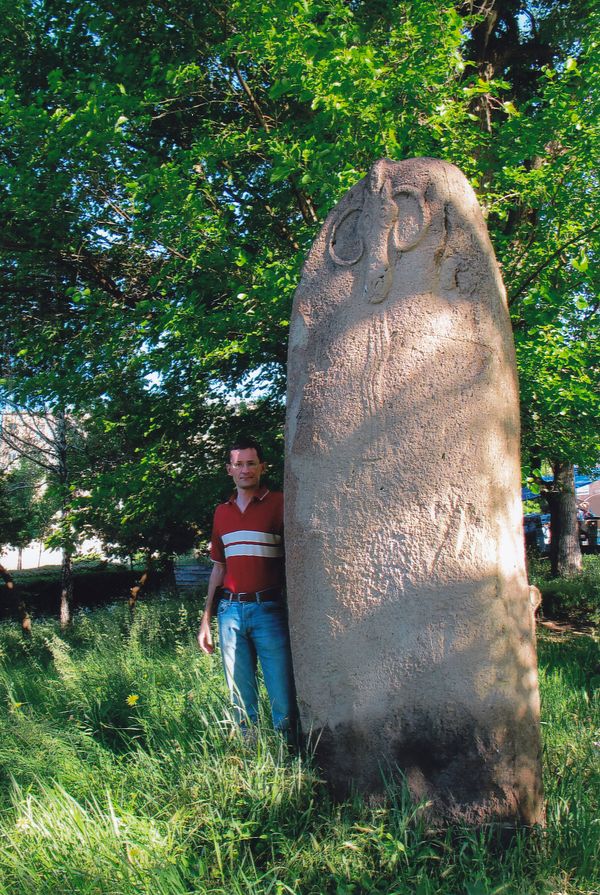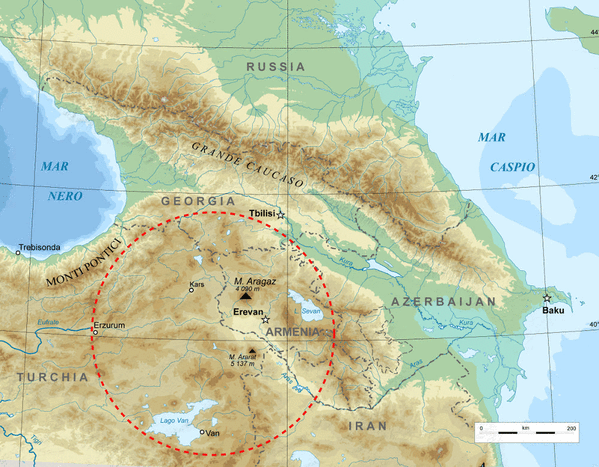Ancient medieval legends tell us of how the peaks of the American mountains were populated by giant dragons, semi-god beings who had the task of guarding the sacred springs, and perhaps personified in megalithic steles decorated in important places in high altitude pastures, between 2,000 and 3,000 metres.
These steles are called ‘vishap’, meaning ‘dragon’ in Armenian, and these are basalt monoliths, placed in a vertical position, which can reach 5 metres in height. Two types have been found: on the first is the fur of a sacrificed goat, which suggests a commemoration of a religious practice of removed and worked upon skin, with the head still attached, as well as the curved horns and the extremities.
The second is worked into the shape of a fish, with gills and fins, and certainly related to the cult of the sacred animal in the mountain springs. In some examples, the iconographies are changing on the same stele, representing goat’s skin draped on the belly of a fish, demonstrating that it is the very same artistic and cultural phenomenon.

Pavol Hnila, co-director of the Dragon Stones Archaeological Project, with a vishap in the form of a goat.
Dragon Stones Archaeological Project has dealt with this phenomenon since 2012, the first excavation project to examine these metallic steles, directed by Alessandra Gilibert (Ca’ Foscari University), Arsen Bobokhyan (Armenian National Academy of Sciences) and by Pavol Hnila (Freie Universität Berlin), met when they were PhD students at the Graduierten-Kolleg “Anatolia and its neighbours” at the University of Tübingen, in Germany.
The archaeological mission examined at the Karmir Sar site, the “Red Mountain”, at 2850 m in altitude and 20 km from the last village situated at the bottom of Mount Aragats, the most vast offshore pasture of the entire region, with two springs in which eleven vishaps were identified, as well as burial mounds and rock engravings from the 3rd and 2nd centuries B.C.. The objective of this is to trace the original chronological horizon of the artifacts to identify the archaeological and landscape context. These steles are the oldest monumental sculptures in the whole Caucasus area and date back to the transition period between the Neolithic and the Chalcolithic, but investigations are still ongoing.

In red: the area of diffusion of the dragon stones
It is hard to say what the meaning of the artifacts was within the community that produced them. There were few ancient societies like this, apparently void of social stratification, that invested energy and resources into artifacts of this magnitude.
If religion has always had the objective of smoothing out the differences arising from unequal social systems isn’t a relevant factor, what could be the anthropological meaning of vishaps? As there are no signs of cult practices following their creating, it is thought that they could have been erected during the collective events that involve dozens of people and that is aimed at defusing internal conflicts born among the pastors of different tribes, who were perhaps competing for the best pastures and resources in an area with an unfavorable climate,characterised by strong temperature ranges, storms and hailstorms.
The stones of the dragon were to be created during a symbolic event in which means and labor-power were shared, carving a symbolic and religious system shared by different tribes into stone, which are capable of undermining possible conflicts between them.
The only monograph on the subject, based on field observation, dates back to 1931, and was published by the Georgian archeologist and linguist Nicolaj Mar with the title “Les Vishap”. The Dragon Stones Archaeological Project is thys the first excavation project that investigates these megalithic steles and that will provide anthropological information on the phenomenon.
Valentina Gennaro
Links for further information:
Dragon Stones Archaeological Project:
https://www.youtube.com/watch?v=gRyVA1kpXEk
https://iris.unive.it/handle/10278/3697059#.WrT0yOjOXIU
https://iris.unive.it/browse?type=author&authority=rp08163&authority_lang=en#.WrUTxujOXIU
Journal Archeo.it: http://archeo.it/










